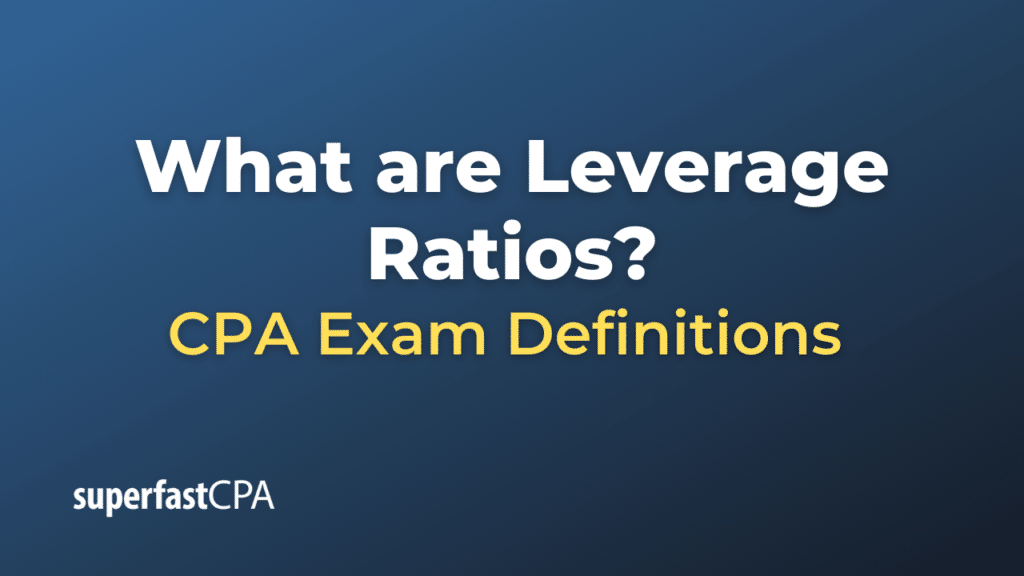Leverage Ratios
Leverage ratios are financial metrics used to measure a company’s ability to meet its financial obligations. They provide an indication of the company’s long-term solvency and highlight the extent to which its operations are funded by debt as opposed to equity.
The following are some of the most commonly used leverage ratios:
- Debt Ratio: This is the proportion of a company’s assets that is financed by debt. It is calculated as total debt divided by total assets. A higher ratio suggests higher financial risk because a larger proportion of the company’s assets are financed by debt.
- Debt to Equity Ratio (D/E): This ratio compares a company’s total debt to its shareholders’ equity. It’s calculated as total debt divided by total equity. A higher D/E ratio indicates that the company has been aggressive in financing its growth with debt, which can result in volatile earnings due to the additional interest expense.
- Equity Ratio: This ratio, a complement to the debt ratio, measures the proportion of a company’s assets financed by shareholders’ equity. It is calculated as total equity divided by total assets.
- Times Interest Earned Ratio (TIE): Also known as the interest coverage ratio, it measures how many times a company can cover its interest charges on a pre-tax basis. It’s calculated as earnings before interest and taxes (EBIT) divided by interest expenses. A lower ratio can be a red flag for potential creditors as it indicates the firm might have difficulty paying its debt obligations.
- Debt Service Coverage Ratio (DSCR): This ratio measures a company’s ability to service its current debts by comparing its net operating income with its total debt service obligations. A DSCR of less than 1 means the company doesn’t generate enough cash flow to cover its debt obligations.
These leverage ratios are used by investors, creditors, and other market participants to assess a company’s financial health and risk profile. However, what is considered a “healthy” or “normal” ratio can vary widely between industries, so it’s important to compare a company’s ratios with those of other companies in the same industry.
Example of Leverage Ratios
Let’s consider an example to understand how leverage ratios work. Imagine we have a hypothetical Company X with the following financials:
- Total Assets: $1,000,000
- Total Debt (liabilities): $600,000
- Total Equity: $400,000
- Earnings Before Interest and Taxes (EBIT): $150,000
- Interest Expense: $50,000
Using these figures, we can calculate the following leverage ratios:
- Debt Ratio:
Total Debt / Total Assets = $600,000 / $1,000,000 = 0.6 or 60%.
This means that 60% of Company X’s assets are financed by debt. - Debt to Equity Ratio (D/E):
Total Debt / Total Equity = $600,000 / $400,000 = 1.5.
For every dollar in equity, Company X has $1.5 in debt. - Equity Ratio:
Total Equity / Total Assets = $400,000 / $1,000,000 = 0.4 or 40%.
This means that 40% of Company X’s assets are financed by equity. - Times Interest Earned Ratio (TIE):
EBIT / Interest Expense = $150,000 / $50,000 = 3.
This indicates that Company X’s operating earnings are 3 times its interest expenses.
By looking at these ratios, an investor, creditor, or analyst can gain a better understanding of Company X’s financial leverage and its ability to meet its financial obligations. For example, a debt ratio of 60% might be concerning if most companies in the same industry have a debt ratio of 30%. Similarly, a times interest earned ratio of 3 would be seen as more favorable compared to a ratio of 1.5.
However, these ratios should not be considered in isolation, but should be used along with other financial ratios and information to build a complete picture of a company’s financial health.













